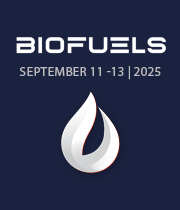Sanjeev Gajjela, Tomato Sustainables LTD, United Kingdom
Green hydrogen is emerging as a vital solution for decarbonising the aviation industry, showcasing significant potential to reduce greenhouse gas emissions. This study examines the latest advancements in green hydrogen technologies and their applications for sustainable aviation. [....] » Read More




























Title : Revolutionizing bioplastics with yeast cell factories
Susan Newman, Integrated Lipid Biofuels, United States
Welcome to the future of sustainable food packaging! Integrated Lipid Biofuels introduces a groundbreaking innovation in the biotech world with our novel yeast cell factory, designed to produce biodegradable and compostable PHB bioplastic. This isn't just any bioplastic&mdash [....] » Read More
Title : Quality variation in market biofuels and the effect on tailpipe emissions
Nick Molden, Emissions Analytics, United Kingdom
Biofuels come in many different forms, with different chemical compositions and, consequently, create different emissions when they are burnt in an engine. Variations in chemical composition may be natural effects of the feedstocks within legal standards, or evidence of non- [....] » Read More
Title : Combustion performances of advanced cooking stoves using woody and herbaceous pellets as fuel
Magnus Stahl, Karlstad University, Sweden
In Africa, biomass is primarily used in the form of wood and charcoal for heating and cooking (WBA, 2020). South of the Sahara Desert, wood fuels and charcoal account for more than 90% of the traditional biomass used in energy production (Smeets et al., 2012). In 2019, Africa was [....] » Read More
Title : Ultra modern patented technology to convert agriwaste/MSW/ slaughter house effluent/lake waste/high cod distillery spent wash to 99% pure renewable hythane (hydrogen+methane)
Atul Saxena, Growdiesel Ventures Limited, India
Effluent coming from distilleries is have very high COD that is dangerous to climate. Disposal of liquid effluent from distilleries is a very big challenge. We have developed a technology to extract cleanfuel like Renewable Natural Gas and very high quality liquid Biofertlizer fr [....] » Read More
Title : The influence of operational parameters on biological methanation in trickle-bed reactors
Maria Nordio, Ricerca sul Sistema Energetico (RSE), Italy
Biological methanation (BM) is a sustainable technology for methane (CH?) production, utilizing microbial metabolism to convert hydrogen and carbon dioxide. As a key component of Power-to-Gas (PtG) systems, BM facilitates energy storage and greenhouse gas mitigation by integratin [....] » Read More
Title : Anaerobic digestate centrate as a key resource to improve sustainability in biogas purification and upgrading to biomethane
Feliu Sempere Nacher, Global Omnium Medioambiente S.L., Spain
This work aims to foster the deployment of biogas valorisation technologies by decreasing operating costs (OPEX) treating anaerobic digestate and biogas, as well as to decrease their pollutant emission. A disruptive circular approach that intensifies the biowaste-water-energy nex [....] » Read More
Title : Biobased specialty chemicals for the mineral slurries
Marcelo Henrique De Olivieira Mrtvi, Omya International AG, Switzerland
Minerals play a fundamental role in modern society, providing essential raw materials for infrastructure, technology, and everyday products. From the metals in our smartphones to the minerals used in renewable energy systems, nearly every aspect of modern life depends on these re [....] » Read More
Title : The impact of slow pyrolysis bio-oil as co-processing load in delayed coking unit based on chemical characterization of light gas oils via GC×GC-TOFMS
Nathalia Pontes, Universidade Federal do Rio de Janeiro, Brazil
Bio-oil presents a significant opportunity to reduce fossil carbon emissions by up to 70 % during the production of renewable products. Co-processing bio-oil in fossil refining processes can diversify the energy matrix, aligning with the goals set forth by the Paris Agreement for [....] » Read More
Title : Machine learning-enabled techno-economic and environmental analysis of succinic acid production from biodiesel byproduct glycerol
Diego Andres Ordonez, Pontifical Catholic University of Rio de Janeiro, Brazil
This study establishes a machine learning (ML)-enabled framework for a comprehensive techno-economic analysis of bio-based succinic acid (SA) production using glycerol derived from biodiesel production. The primary objective is to optimize the minimum product selling price (MPSP) [....] » Read More
Title : Waste plastic upcycling via solvothermolysis: A pathway to bio-oil and carbon-rich solid production
Zulqarnain, Korea Institute of Energy Research, Korea, Republic of
The rapid increase in plastic consumption and waste generation has emerged as a critical environmental issue, affecting all forms of life. Consequently, growing research efforts are being directed toward converting waste plastics into valuable resources. One promising approach is [....] » Read More
Title : Fermentation of Opuntia ficus indica under different temperatures to increase methane production
Simon Gonzalez-Martanez, Universidad Nacional Autonoma de Mexico, Mexico
The cladodes or “leaves” of a cactus, Opuntia ficus indica, are a typical human food in Mexico. The production reached almost 900,000 ton/y. Approximately 5% gets lost during manual harvesting because the cladodes do not comply with commercial standards. Opuntia is bi [....] » Read More
Title : Synthesis and performance study of biomass derived supercapacitor electrode for energy storage
Manoj Tripathi, Jaypee Institute of Information Technology, India
The capabilities of biomass derived electrodes and their use in the field of energy storage is a promising area of research. Commercial (Industrial) activated carbon is expensive and has adverse effect on the environment. Switching from industry based activated carbon to biomass [....] » Read More
Title : Effect of charcoal addition on coke properties: A low-emission integrated steelmaking process
Sachchit Kumar Majhi, Tata Steel Limited Jamshedpur, India
The iron and steel industry is one of the largest emitters of greenhouse gases, accounting for around ~ 8% of global CO2 emissions. One way to reduce these emissions is to use charcoal, a carbon-rich material derived from the pyrolysis of biomass, as a substitute for coal in the [....] » Read More
Title : Structural analysis of glycoside hydrolase family 43, beta-xylosidase and its complex with xylose from mesophilic Pseudopedobacter saltans
Poorvi Vishwakarma, All India Institute of Medical Science, India
In bioethanol production, enzymatic saccharification of lignocellulosic biomass is cost limiting step. Therefore, to reduce the production cost of bioethanol, the structural insights of new efficient Carbohydrate-Active enZYmes (CAZy) with high catalytic efficiency, productivity, [....] » Read More
Title : A study on sustainable feedstock utilization: Decentralized biofuels supply chain for rural development in India
Aryaman Jakhar, Delhi Technological University, India
India, as one of the fastest-growing economies in the world, faces a significant challenge in meeting its energy demands. Despite its natural resources, the country relies heavily on petroleum-based fuels for its transportation sector, with around 88% of fuel requirements importe [....] » Read More
Title : Co-digestion of steam pretreated wheat straw and municipal sewage sludge at varying concentrations of solids
Maria Esther Medina Villafuerte, Universidad Mayor de San Simon, Bolivia
Wheat straw is one of the most abundant agricultural residues in the world and can be used for production of energy carriers, e.g. methane through anaerobic digestion (AD). In previous studies, stable co- digestion of steam-pretreated wheat straw (PWS) and combined sewage sludg [....] » Read More
Title : Biodiesel production: Enhanced lipid productivity and biosynthesis gene response of indigenous microalgae under different nutrient conditions
S'fiso Thuthukani Gumbi, University of KwaZulu-Natal, South Africa
Microalgae have great potential as biodiesel feedstock, primarily due to their rapid growth rates and higher lipid yield. To enhance the total production of neutral lipids, it is crucial to optimize the microalgae growth parameters by inducing abiotic such as nutrient starvation [....] » Read More
Title : Biowaste to biofuels - A circular green economy enabler
Ruchi Saxena, Growdiesel Ventures Limited, India
Global challenges of waste generation and fossil fuel dependence. Present the concept of circular economy: reduce, reuse, recycle, and recover. Brief overview: BioWaste as an untapped resource and its potential in the green energy landscape. The Biowaste Challenge [....] » Read More
Title : Predicting the biogas production in an electrical voltage-applied reactor using real-time data monitoring and deep learning
Ali Ashraf Joolaei, Inha University, Korea, Republic of
Modeling is widely used to understand anaerobic digestion (AD) and predict biogas production. However, the modeling of electrical voltage (EV)-applied reactors has been scarcely explored. This study introduces two strategies to enhance the predictability of biogas production rate [....] » Read More
Title : Biodiesel production: Enhanced lipid productivity and biosynthesis gene response of indigenous microalgae under different nutrient conditions
S'fiso Thuthukani Gumbi, University of KwaZulu-Natal, South Africa
Microalgae have great potential as biodiesel feedstock, primarily due to their rapid growth rates and higher lipid yield. To enhance the total production of neutral lipids, it is crucial to optimize the microalgae growth parameters by inducing abiotic such as nutrient starvation [....] » Read More
Title : Obtaining biofuel from the deoxygenation of bio-oil using nanostructured catalysts
Andres Felipe Caballero Medina, Universidad de Antioquia, Colombia
This study developed catalysts based on nano-sized zeolite Y (nanoZY) modified with transition metals (Ni, Mo) and rare earths (La, Ce), for the transformation of guaiacol and highly oxygenated bio-oil into bi-fuels with fossil fuel-like properties by catalytic hydrodeoxygenation [....] » Read More
Title : Pongamia pinnata: Harnessing plant-based lipids for renewable energy
Jahangeer Ahmed, Smart Yields PvT Limited, Pakistan
Biodiesel has been recognized as good compatible and possible alternative of non-renewable petro diesels because of its similar characteristics to petroleum diesel. Although, mostly homogeneous catalysts are used for trans-esterification for maximum oil to diesel conversion but r [....] » Read More